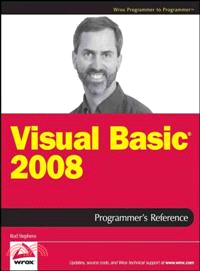| FindBook |
有 1 項符合
VISUAL BASIC 2008 PROGRAMMER'S REFERENCE的圖書 |
 |
VISUAL BASIC 2008 PROGRAMMER'S REFERENCE 作者:STEPHENS 出版社:JOHN WILEY & SONS 出版日期:2008-01-18 |
| 圖書館借閱 |
| 國家圖書館 | 全國圖書書目資訊網 | 國立公共資訊圖書館 | 電子書服務平台 | MetaCat 跨館整合查詢 |
| 臺北市立圖書館 | 新北市立圖書館 | 基隆市公共圖書館 | 桃園市立圖書館 | 新竹縣公共圖書館 |
| 苗栗縣立圖書館 | 臺中市立圖書館 | 彰化縣公共圖書館 | 南投縣文化局 | 雲林縣公共圖書館 |
| 嘉義縣圖書館 | 臺南市立圖書館 | 高雄市立圖書館 | 屏東縣公共圖書館 | 宜蘭縣公共圖書館 |
| 花蓮縣文化局 | 臺東縣文化處 |
|
|
- 圖書簡介
Providing programmers and developers of all skill levels with a comprehensive tutorial and reference to Visual Basic (VB) 2008, Microsoft MVP Rod Stephens presents a broad, solid understanding of essential topics on the latest version of VB. He explains the forms, controls, and other objects that VB furnishes for building applications in a modern windows environment. Plus, he examines the powerful development environment that makes VB such a productive language, and he delves into the VB language itself to show you how to use it to perform an array of important development tasks.
Note: CD-ROM/DVD and other supplementary materials are not included as part of eBook file. - 作者簡介
Rod Stephens started out as a mathematician, but while studying at MIT, discovered the joys of programming and has been programming professionally ever since. During his career, he has worked on an eclectic assortment of applications in such fields as telephone switching, billing, repair dispatching, tax processing, wastewater treatment, concert ticket sales, cartography, and training for professional football players. Rod is a Microsoft Visual Basic Most Valuable Professional (MVP) and ITT adjunct instructor. He has written 18 books that have been translated into half a dozen different languages, and more than 200 magazine articles covering Visual Basic, Visual Basic for Applications, Delphi, and Java. He is currently a regular contributor to DevX ( www.DevX.com ). Rod ' s popular VB Helper web site www.vb-helper.com receives several million hits per month and contains thousands of pages of tips, tricks, and example code for Visual Basic programmers, as well as example code for this book.
- 目次
Acknowledgments.
Introduction.
Part I: IDE.
Chapter 1: Introduction to the IDE.
Chapter 2: Menus, Toolbars, and Windows.
Chapter 3: Customization.
Chapter 4: Windows Form Designer.
Chapter 5: WPF Designer.
Chapter 6: Visual Basic Code Editor.
Chapter 7: Debugging.
Part II: Getting Started.
Chapter 8: Selecting Windows Forms Controls.
Chapter 9: Using Windows Forms Controls.
Chapter 10: Windows Forms.
Chapter 11: Selecting WPF Controls.
Chapter 12: Using WPF Controls.
Chapter 13: WPF Windows.
Chapter 14: Program and Module Structure.
Chapter 15: Data Types, Variables, and Constants.
Chapter 16: Operators.
Chapter 17: Subroutines and Functions.
Chapter 18: Program Control Statements.
Chapter 19: Error Handling.
Chapter 20: Database Controls and Objects.
Chapter 21: LINQ.
Chapter 22: Custom Controls.
Chapter 23: Drag and Drop, and the Clipboard.
Chapter 24: UAC Security.
Part III: Object-Oriented Programming.
Chapter 25: OOP Concepts.
Chapter 26: Classes and Structures.
Chapter 27: Namespaces.
Chapter 28: Collection Classes.
Chapter 29: Generics.
Part IV: Graphics.
Chapter 30: Drawing Basics.
Chapter 31: Brushes, Pens, and Paths.
Chapter 32: Text.
Chapter 33: Image Processing.
Chapter 34: Printing.
Chapter 35: Reporting.
Part V: Interacting with the Environment.
Chapter 36: Configuration and Resources.
Chapter 37: Streams.
Chapter 38: File-System Objects.
Chapter 39: Windows Communication Foundation.
Chapter 40: Useful Namespaces.
Part VI: Appendices.
Appendix A: Useful Control Properties, Methods, and Events.
Appendix B: Variable Declarations and Data Types.
Appendix C: Operators.
Appendix D: Subroutine and Function Declarations.
Appendix E: Control Statements.
Appendix F: Error Handling.
Appendix G: Windows Forms Controls and Components.
Appendix H: WPF Controls.
Appendix I: Visual Basic Power Packs.
Appendix J: Form Objects.
Appendix K: Classes and Structures.
Appendix L: LINQ.
Appendix M: Generics.
Appendix N: Graphics.
Appendix O: Useful Exception Classes.
Appendix P: Date and Time Format Specifiers.
Appendix Q: Other Format Specifiers.
Appendix R: The Application Class.
Appendix S: The My Namespace.
Appendix T: Streams.
Appendix U: File-System Classes.
Appendix V: Index of Examples.
Index.
|










